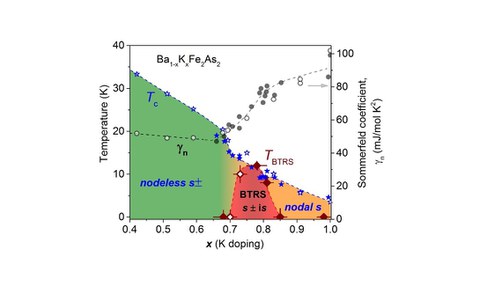May 13, 2020
Research: Superconductivity with broken time-reversal symmetry inside a superconducting s-wave state
Usually, a superconductor is considered as conventional (s - wave) if superconducting state breaks U(1) symmetry only, and unconventional when other symmetries are broken in addition to U(1). Typically, the additional symmetry is a rotational symmetry of the crystalline lattice. However, in some cases, a superconductor can also break spontaneously the time reversal symmetry. As a consequence the superconductor can create magnetic fields all by itself. In this study, it was demonstrated that the superconducting state of the metallic compound Ba1-xKxFe2As2 can break spontaneously time reversal symmetry even in the case when superconducting interactions by itself preserve all symmetries. How is it possible for an s-wave superconductor? It turns out that a two-component superconducting state (s ± is) with broken time reversal symmetry (BTRS) emerges in a narrow doping range because of a competition between two different s-wave states. These two different superconducting order parameters exist because of interactions between several disconnected Fermi surface sheets in the multi-band Ba1-xKxFe2As2 system. The balance between these states is tuned by topological changes of the Fermi surface (Lifshitz transition) resulting in the disappearance of one of the sheets with carriers doping. The phase diagram of the Ba1-xKxFe2As2 system with the BTRS superconductivity revealed in this study is shown in the Figure.
V. Grinenko , R. Sarkar, K. Kihou, C. H. Lee, I. Morozov, S. Aswartham, B. Büchner, P. Chekhonin, W. Skrotzki, K. Nenkov, R. Hühne, K. Nielsch, S. -L. Drechsler, V. L. Vadimov, M. A. Silaev, P. A. Volkov, I. Eremin, H. Luetkens, H.-H. Klauss,
Superconductivity with broken time-reversal symmetry inside a superconducting s-wave state,
Nat. Phys. (2020)

